7 February 2013
In response to great demand, we have decided to publish on our site the long and extraordinary interviews that appeared in the print magazine from 2009 to 2011. Forty gripping conversations with the protagonists of contemporary art, design and architecture. Once a week, an appointment not to be missed. A real treat. Today it’s Fabio Novembre’s turn.
Klat #04, fall 2010.
“It would be nice to do an interview on things that have never been said before: on the Internet you can find almost everything, and with everything that’s out there you could make up any kind of interview…” I meet Fabio Novembre one late afternoon in July. The appointment is at his studio in Milan. His assistants are there, along with the designs he’s working on, a pinball machine and a large pair of compasses made of tin with the profile of Pinocchio designed by Riccardo Dalisi. And Verde, five years old, the elder of Fabio’s two daughters. Between us, on the table, there’s also an old cassette tape recorder: it’s about twenty years old, still works and for the moment there’s no reason to send it into forced retirement. Verde looks at it as if it were a phantom object. For her, as for us, design – as we know it today – is less than a century old, but has already left a series of shadows behind it on the road. Verde draws, Novembre talks. On the Internet there’s an overdose of information, in our memories perhaps, who knows…
Let’s start with Deyan Sudjic: “Design is the language that a society uses to create objects that reflect its purposes and its values. It is the key that lets us understand the world made by human beings.” A bit like Rogers argued when he said that if you look closely at a spoon you can understand many things about the part of the world that produced it. Do you too think that design today – between its iconic objects and its phantom objects – still has the function of a social primer?
I think it’s partially true, even though for some time now we’ve been surrounded by a chaotic explosion of signs that are superimposed on objects. Think of the value the logo has for companies. Companies that have turned into multinationals and that use these logos all over the world, producing a sort of visual colonization. Visual fodder is the same everywhere. Let me give you an example: when I designed the Nemo chair for Driade I wanted an object that would have no geographical connotation (Asian, Western, etc.), an object that would be neither male nor female. Rather than the account of a world, I think what predominates in the design of recent years is the focus on the designer, on his point of view. You’re the one who designs your DNA: if you want, you can recognize yourself in the DNA of very distant parts of the world. That’s why Nemo is the way it is: it was designed by me, an Italian, but it could have been designed in New Guinea.
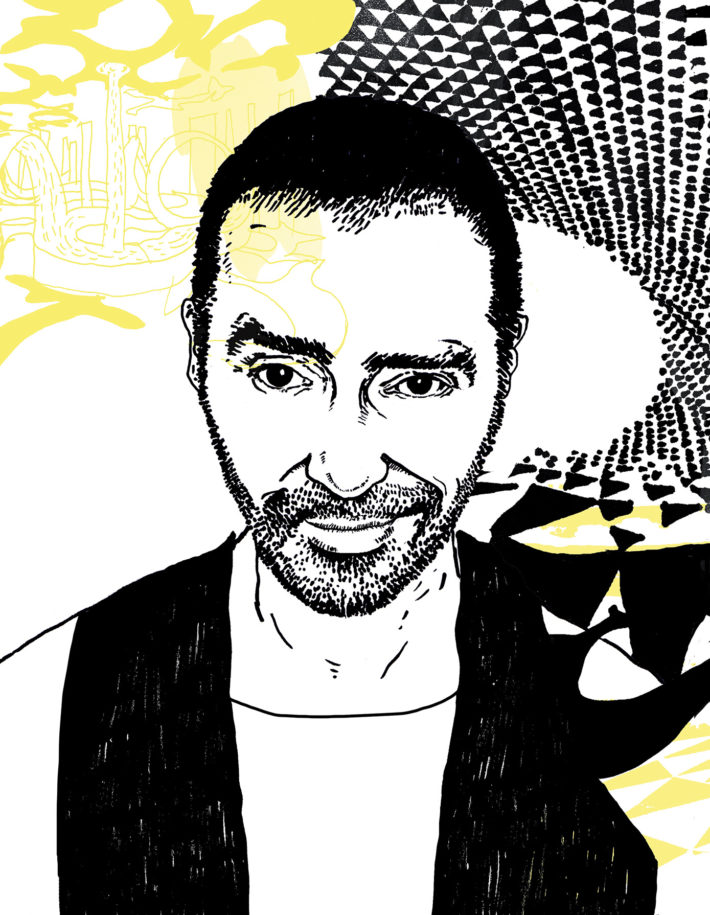
Fabio Novembre. Portrait by Karen Hemmingsen.
“Here” as somewhere else: are we celebrating the end of the great game of Risk between strong states and nations that are weak not just in political and economic terms, but also in aesthetic and cultural ones?
I often try to work out what might be the minimum common denominator of the Italians, what it is that unites them deep down, but I’m unable to go beyond the language. We can only go deep with our language. If you read Shakespeare in the original you don’t understand much, you don’t get the subtleties. You have to read it in translation and then you realize that it has been transferred into another type of poetics. You become aware that the only unifying factor is the language. Nothing else: not the images, not the fashion, not the objects. Even our past has been so heavily digitized that to some extent we no longer hear about it through the memories of our grandparents. I was reading a few days ago about memoro.org, a project set up by four people in their thirties who have decided to collect the reminiscences of people born prior to the 1940s and use them to create a large database of memory. You can listen to their stories: over sixty-one thousand have been gathered. And then? Then what’s left is just an enormous confusion in the tracing of a hypothetical common DNA. To be Italian: but what does that mean? Nothing. Look at the Soccer World Cup: players wear the shirts of their national team only because they were born in a certain place, as if I ought to play for Lecce and not in a team from Milan… Or look at Inter: the club’s fans go wild over a team made up of players of eleven different nationalities: this is a fact!
Soccer as a paradigm of where the world is going?
I’d like to write a book about it. In soccer, just as in art or design, creative identity goes beyond the flag. You can’t say: Picasso was Spanish, his work was an expression of an absolutely Spanish art. Picasso’s art was absolutely international. To talk about identity on the basis of geographical references is outdated: today’s creative people are like the ganglions of a single nervous system.
Perhaps the geometry of opportunities is changing, don’t you think? Someone once said that the future is within the reach of all, but it may not be equally distributed…
Well, that’s obvious. And we’ll have to wait a long time before a great design comes out of Ghana… But in Ghana design, as we understand it, certainly does not play a strategic role. They don’t know what it is. It doesn’t exist, they are unaware of it: they don’t worry about whether they have a great national designer or not. Perhaps it should also be said that what we often believe to be the center of the world is nothing but a tiny part of it. We are talking about a very restricted, snobbish, insignificant circle…
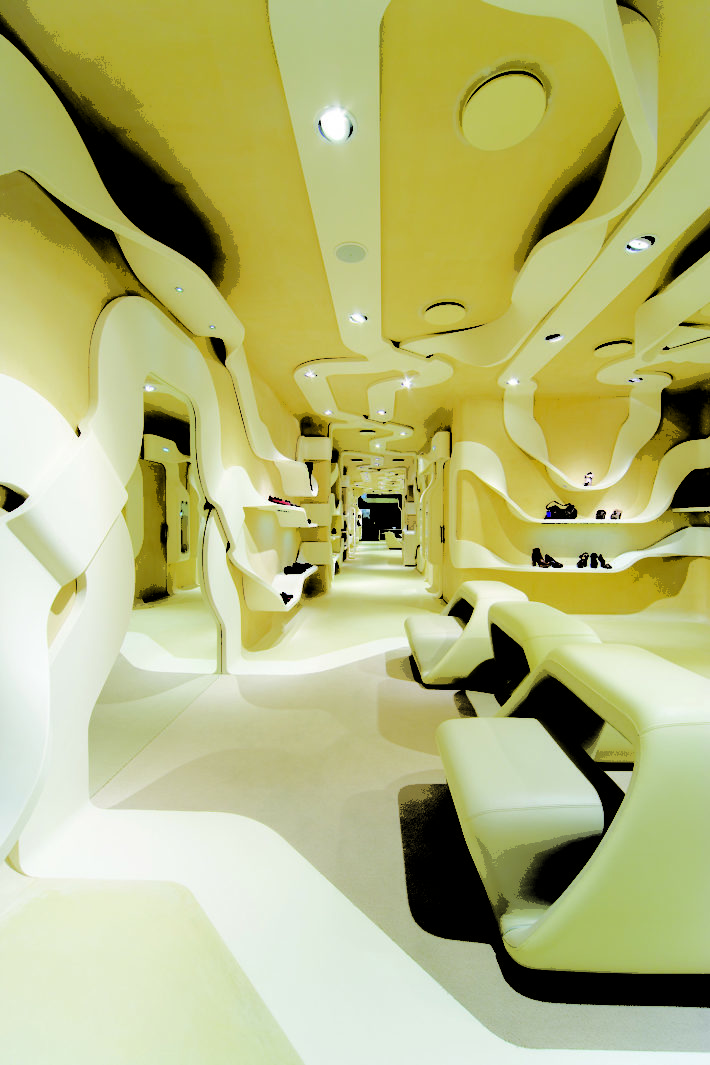
Fabio Novembre, Stuart Weitzman shop, Rome, 2006. Photo: Alberto Ferrero
When does design take on “meaning”?
It takes on “meaning” in experiences like those of Yves Béhar. With his firm fuseproject, Yves has understood that design today has to be done with companies and not for companies. There are designers who fit perfectly into companies. Look at a professional like Jonathan Ive who, along with Steve Jobs, has made Apple a success. Then there are designers like Bouroullec, Newson and Grcic, who are free agents. I include myself in this category. Well, Yves is in the middle: he is halfway between us and the world of design that works in close contact with industry (the so-called design departments…). This is an operation that places itself in a new dimension, that produces a new “meaning.”
Yves Béhar designs objects, but above all he outlines scenarios: in the past he designed the celebrated one hundred dollar laptop with MIT, and this year he has designed corrective eyeglasses for Mexican children. The curious thing is that we hear a lot about these projects at the beginning but – at least as far as I am concerned – I haven’t yet come across a really detailed report on the actual distribution of laptops in Africa: how many, how it’s being done and with what results.
Because the information system is sensationalistic, obsessed with what is new. But Yves’ ventures are still very important. Think of the packaging system he developed for Puma: it represents a reduction of 70 percent in the investment in boxes alone, tons and tons of cardboard. Of course it’s no coincidence that Yves is based in San Francisco, in the apparently schizophrenic California of a Republican governor more Democratic than the Democrats. The California where even the world’s most expensive store on Rodeo Drive has to abide by the rule that says: you can’t use all those watts anymore, and so only low-energy bulbs, whether you’re selling jewelry or manure.
Béhar and innovation. Recently Forbes has put a project online called The Future by Design where the most important element is the leap forward guaranteed by the evolution of technology. To put it more simply, it is claimed that the job of a designer is to redesign the already designed, drawing on cutting-edge “processes.” A discourse that holds for everything: from the transport system to the toaster to the design of interfaces.
On the subject of toasters: recently I saw one designed by Naoto Fukasawa for the Japanese market. Toasters have always had at least two slots, but this one is ultra slim, created for individual use. Fukasawa has not changed the object, he has simply acted to deal with a supposed lack of space. What I ask myself though is: but where is all this leading? We have gone from the cassette to the CD, now we are moving on to the USB flash drive. The container is changing but the real question is another: and the content? From this point of view, if you want to speak of a European approach, I think that there is one last generation convinced that our objects can still carry messages. Yves Béhar places his fine intelligence at the service of bigger causes, without pretending to write the script of the objects he designs. It’s a subtle difference, but one that in a way saves us/me: if I didn’t believe that I would already have given up.
Fukasawa and the revolution of small things. This year one of the Brit Insurance Awards made by the Design Museum in London went to an ultra-flat electric plug, designed for use with ever slimmer computers. Rather as if the Apple imagery, thronged with ever more icy and less bulky objects, had imposed a “diet” that has turned into a trend with a powerful impact.
The process of slimming down objects is made necessary by questions of space, but it’s not the only factor. Until a short time ago, cellphones followed the same trend, becoming as thin as cuttlefish bones. Now the mood seems to have changed: the new generation of smartphones are filling out again. It is as if a trend had been taken to its limit, only to find a sort of balance again. Trends also serve to force things, to stretch the elastic, to find the breaking point. Real equilibrium is only found in the subsequent phase.
Fabio Novembre and architecture: will you ever stretch the elastic?
I’ve never designed a building only because there has never been a real opportunity to do so. And there is also a problem of familiarity: to learn how to do things, you simply have to do them, to acquire the habit. There are designers like Karim Rashid who do really a lot of work and – while not going along with their facile prolificacy – you realize that the more they do, the less mistakes they make. Familiarity serves to refine your approach, to make you more and more the master of what you do, and architecture is no exception to the rule: it needs to be practiced. I hope to familiarize myself with it as soon as possible, but at this moment it’s not one of the opportunities that are being offered me.
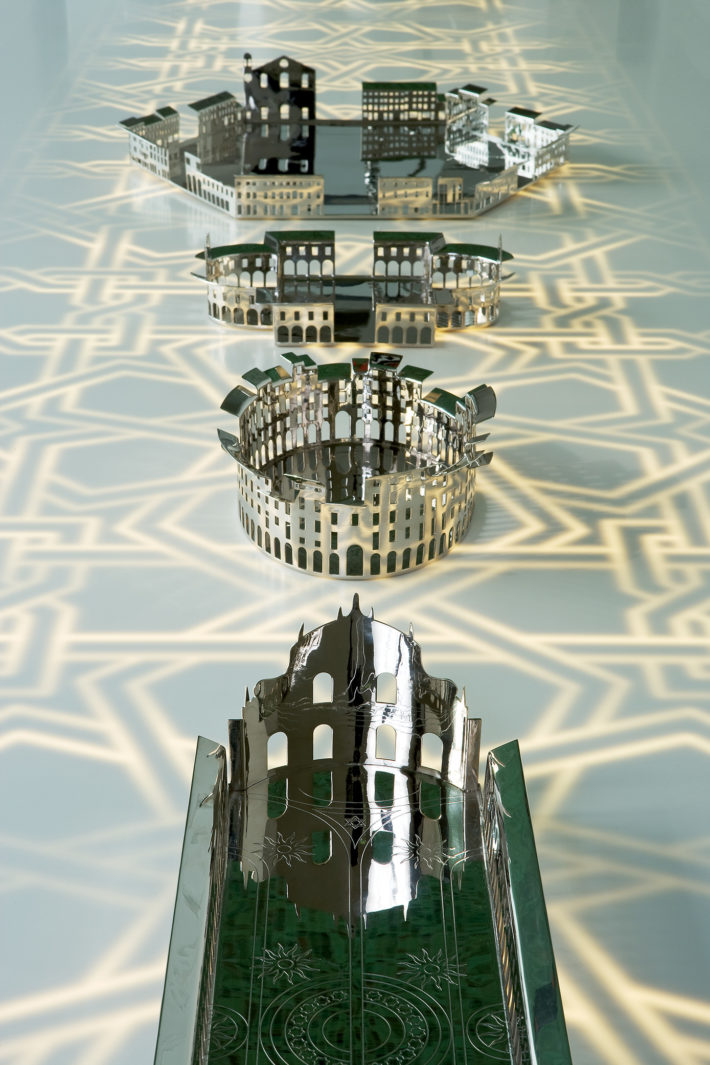
Fabio Novembre, 100 piazze, 2007. Design for Driade. Photo: Pasquale Formisano.
What do you mean?
It’s interesting to carry out an analysis of my works today. I should be in the ideal condition, have the level of maturity to be able to do anything, but in the end I’m busy with things that don’t get me excited. We are going through a period of stalemate, lacking real enthusiasm. It’s a time of waiting and seeing from the financial, economic, cultural and design viewpoint. We are all waiting, as if we ought to be able to make out the signs of something that is coming, but we find it difficult to foresee what shape it’s going to take. A while ago I presented my latest book at the offices of the Milan Association of Architects: Il design spiegato a mia madre (“Design Explained to My Mother,” published by Rizzoli, ed). Franco Raggi was there. He came up with some criticisms, arguing that the corpus of my work is good but superficial, and often disconnected. Although I don’t share his view, my reply was clear: this is a period in which it is impossible to be strategic, we can only be tactical. In this historical context it is difficult to organize your actions perfectly, because those actions are often small moves along a zigzag course. It’s guerrilla fighting, not war fought in a theater laid out like a chessboard. You realize you have to come up with instant solutions to problems. And in such a situation it’s also very hard to be ambitious…
Yesterday, Marcel Duchamp played chess. And us?
We are born into this. I opened my studio in 1994 and I’ve never felt that anyone around me was happy with the economic situation: indeed, crisis has been perhaps the word most bandied about. I often use the metaphor of walking uphill because according to others that is exactly what we are doing. But for me it’s as if we were walking on level ground, as I have always only walked uphill. The eighties were wonderful? In the eighties I was studying, I was a kid. I don’t really know what they were like.
Do you need to be eighty years old like Alessandro Mendini to believe in utopia, the theme that he has revived with his new Domus?
I believe that the utopia of which Mendini speaks is the offspring of his old mappings of the field. Mendini’s utopia lies in his memory, it’s not a utopia for our days. It’s his dream. I talk about dreams too, but I prefer to speak of personal dreams. I’m not able to talk about generalized utopias. I can recount my dreams, share them, and all this is a matter of generations. We are children of the Internet: sharing is a choice you make. You can accept me as a friend, you can accept my friendship, read my blog. The underlying process is a mechanism of acceptance that you can’t impose from above. Sharing has nothing to do with the utopia promoted by great sowers of ideas like Mao Zedong.
So it’s impossible to cherish new utopias?
What sense does it make to speak of utopia today? Lets start out from the etymology of the term: utopia means absence of place, an ideal direction; it’s a sort of signpost. We ought to begin to tone down its significance. It’s not a promised land, it’s an attitude, an ethos, an item of clothing to wear from day to day. Perhaps this is the new utopia. A garment you put on in the morning, take off in the evening, fold up and put back on the next day. Turns are never U-turns. Over the entire long span of a life, a turn of a hundredth of a degree leads to a displacement of a hundred kilometers along the axis which you were following. The hundredth of a degree today is more important than the U-turn of tomorrow. It’s those hundredths of a degree that take you somewhere completely different. Think of ecology, of attention to the environment: it’s not that all of a sudden you have to turn your life upside down; the little things count a lot. I think it’s important to speak of ethos as a “strategic” tactic for the reevaluation of the present.
Is it still possible to think strongly today?
I tried to do it with the reprise of the Futurist Manifesto that I had called the Manifesto of the Present as Ism. Because for me what matters is the present. The past has gone, we turn it into memory. The future is utopia, non-place, it’s still to come. The present is now. The present is child of the past and stake in the future. Life is an eternal present, like a film made up of many small frames: taken one by one they are so many “presents.” To make a film we have to concentrate on creating every single frame. And to make a frame you have to live in the moment, you have to bring it into focus, because if it is out of focus, over a long distance there will be scenes that you are unable to understand. I believe it is very important to concentrate on the present, to take hold of it. The future and the past have made us lose sight of the everyday. You see it in Italy on a daily basis: you dig a hole, you see walls from who knows what century and you call a halt to everything. An American goes to Rome, sees the ruins of the Roman Forum and comments: all these stones… Well, I find such ignorance touching, but it also gives me a feeling of joy since it signifies a capacity to move forward. Our cities are built in layers. If we were always to stop because of the earlier layers, we would not be able to go ahead: we would no longer be here to bear witness to our time. I think we have to pursue the contemporary just as Beethoven did and the Sex Pistols have done. Beethoven is defined as classical only because so much time has passed, but both he and the Sex Pistols represent contemporaneity.

Il Fiore di Novembre. Cover by Emiliano Ponzi.
In 2008 the Rotonda della Besana, in 2009 the Triennale: two major monographic exhibitions in Milan with the designs and stages of a life. What’s your assessment at the end?
The exhibition at the Besana was a monographic retrospective, with a curator like Beppe Finessi, the classic exhibition going by the book. When, just a year later, the Triennale asked me to put on a new exhibition, the project created more difficulties for me than for them. After only twelve months you haven’t invented another story, the pieces are still the same. For the Triennale I chose to present the course of my development from a completely different perspective: there was no curator, nor designer of the exhibition. It is as if I had put on display all the world of dreams hidden behind my work. The catalogues of the shows at the Besana and the Triennale also represent well the two levels of interpretation, dividing the field between the reality of photos and the fantasy of illustrations. I believe the catalogue of Il fiore di Novembre (“November’s Flower,” ed) is unprecedented in its total absence of photos. All my works have been transfigured by Emiliano Ponzi, as if in a storyboard in which my texts and his illustrations were born out of our discussion of the subjects together. Viewed from a distance, the exhibition at the Triennale resembles me more. There was a more passionate approach. Then there was also the grief for the loss of my mother, which affected me deeply: that flower is dedicated to her, the sections of the flower were like the CAT scans of her illness, the red was the physical depth of our relationship. I left home when I was eighteen and I didn’t think that the death of a parent would have been so painful. Then it happened and the shock was very great. Your mother represents, symbolically as well, your threshold of entry into the world. When she’s no longer there, that world seems to come to an end, no longer to exist. In this sense, my work has no secrets. In the image Emiliano created for the cover I am ripping open my breast to find a flower. My work delves into my deepest obsessions. I don’t want it to remain on the surface, but for it to be the fruit of the stimuli that come from my experience.
Design has always been exhibited and sold in museums and galleries, almost as if there were more objects on display than actually used. What do you think about this?
I used to think it was a very bad thing indeed, but today I realize that it’s an unstoppable trend. It’s the same problem you have on the Internet, where all you need is a little drawing and the project doesn’t even have to be realized. Put up the bill and occupy the seat from a distance, and the theater can even be empty. The truth is that manufacturers are bringing out products in ever more ridiculously large numbers, while we are producing high craftsmanship. You have to wonder what the difference is between Giuseppe Maggiolini and Maarten Baas. It all seems a bit speculative to me: which do you prefer, a concept store or industry? For my own part, I continue to prefer the one which takes greater risks, in other words industry, and which doesn’t tell you: good, I like your work, I’ll put it on display, and then if it sells I’ll give you a percentage…
Going back to objects, Milan has been the home of one of the most successful periods in international design: that of the grand old men of design made in Italy, a really heavy yoke around the neck. Is it possible to get rid of it?
To some extent I have succeeded. Celebration of the heroic past can devalue the time you’re living in. My action and reflection on the present require knowledge of the past, but without idealizing it. We are living in our own time, we have no choice. We can only fill it with meaning. When we speak ill of the time in which we live, of our cities, we are in fact running ourselves down. Life is a long process of reconciliation with ourselves, more than with others. Today, at the age of forty-three, I can say that I’m perfectly reconciled with myself. I’m always trying to create synergies. Two weeks ago I went to a wedding: on the way there in the car my wife Candela and I were listening to Lou Reed. In the end we put two and two together: Lou Reed was part of a marvelous milieu, that of Andy Warhol’s Factory, a ferment that saw them acting as a team. Lou Reed’s songs are portrayals of the times in which he lived. They are personal microhistories, stories of people arriving in New York. There’s the barman and there’s the woman who wants to be a dancer and who works as a whore. Lou Reed in this sense is key. I thought that if I knew how to draw I would dedicate the next few months to illustrating the songs of Lou Reed. They are paintings, painted with words. Lou Reed has the ability to transfigure reality. If we could succeed in seeing the present through the eyes of art, making it more beautiful, then we would have really hit the jackpot.
And instead?
Instead we live in ever greater isolation. Warhol used to say: you can come to my Factory and stay in it, so long as you don’t touch me. He displayed an aversion for people, but he had a morbid curiosity about life, which he could not do without because he fed on it.
Andy Warhol, for many a genius, certainly not a benefactor…
That’s for sure: it’s no accident they called him Drella: a cross between Dracula and Cinderella… But do you know how much energy he brought into circulation?
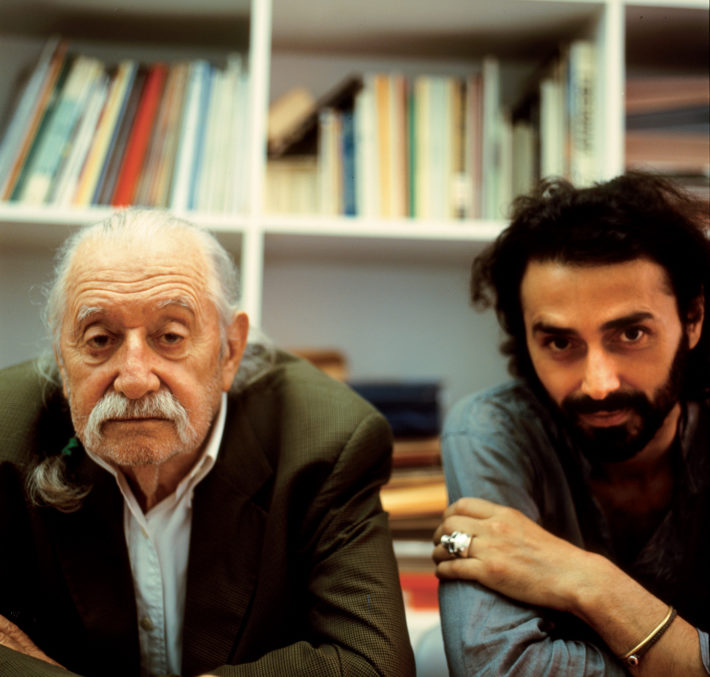
Ettore Sottsass and Fabio Novembre, 2007. Photo: Leo Gullbring.
Energy but destruction too: to get enough to eat sometimes you need a good dose of cynicism too, don’t you think?
Destruction and self-destruction are always just a step away: meeting Candela and having two daughters, I have chosen to walk a little farther away from the “wild side.”
Let’s go back to the great masters and the world of design for the home. Some people say: after them nothing.
Let’s admit it: the great masters of design were a group of successful frustrated people. They all had degrees in architecture, but were prevented from building because after the war the constructors were already speculators. This was how it went: so you have some aesthetic hang-ups? Well bye-bye then… I’ll call my surveyor, who does what I want.
Vico Magistretti built things.
Vico Magistretti built later on, for very wealthy and snobbish clients. In any case, he didn’t design housing projects. The great masters, I repeat, were amiable, highly talented but frustrated architects. They said: sorry, we’re working on a Copernican revolution, rebuilding society again from its objects. But this choice was determined solely by the fact that there was a wall on the other side. After the war, there was no city to construct, at least by their criteria. The real estate business was already greedy in 1946 and almost nothing has changed since then: horrible things were built and are still being built. In Milan too. Take a building under construction: look at who’s working on it and you’ll never find the name of someone known for their design work, only ten thousand mister nobodies. Have you heard the story of the use of poor quality concrete in South Italy? It’s the absence of a culture linked to building that has massacred our country. After the war, the idea of starting from scratch by designing objects was a romantic one, but it has not produced the effects that our successful frustrated friends imagined. Their dream may have nourished our minds, our own ability to dream, but it has not changed our life. Look at the average Italian home: it’s a home without taste. Those objects have never broken though the wall of industrial production. Even today, if we look at the numbers, we can say that what we are doing is just high craftsmanship.
With what results?
Today it is the theoretical impact that is important, the shockwave has not reached into everyone’s homes as the original utopia promised. My generation does not make objects but
meta-designs. And we have to be content with that.
And how has industry reacted?
It’s very difficult. While Cesare Cassina and Piero Ambrogio Busnelli could once make five mistakes in a row and risk nothing, today the first mistake can put you out of the running. It is clear that today no one wants or is able to take a risk. Industry follows trends that have already been set, it imitates things that are successful. Research is penalized.
The story of the great design brands is often rooted in a family business. Today many brands have been gathered under the broad umbrella of the investment funds. It’s not that these new assets have to some extent also had an influence on the willingness to take “risks”?
There are companies that have lost sixty per cent of their sales because of an advertising campaign that turned out badly: perfect perhaps, but that didn’t go down well with the market. This is to say that if you try to go off the beaten track today, the market will punish you. Ours is a sphere for a few insiders, for intellectuals. We are marginal.
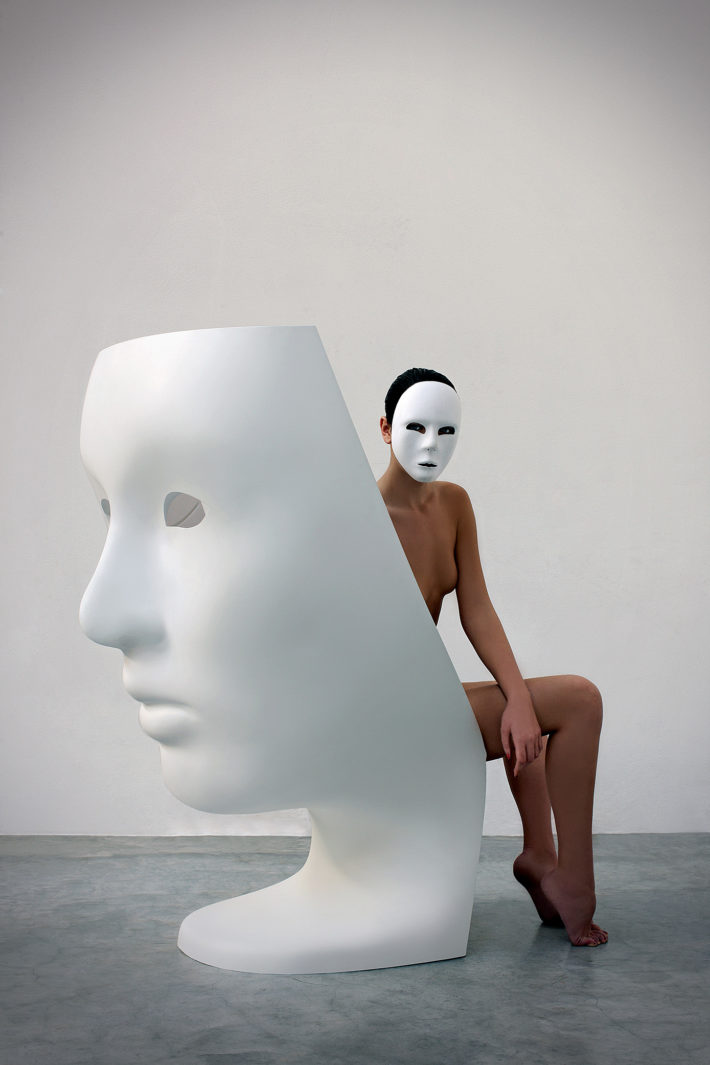
Fabio Novembre, Nemo, 2010. Design for Driade. Photo: Settimo Benedusi.
On what criterion do you accept or reject a project?
Instinct. I can tell at once when there’s room to grow together, and I’m no longer put off by someone’s character. Maturity has taught me that you may feel very distant from the person you’re working for, but that doesn’t mean you can’t have common goals. And it’s never a question of economics!
Ettore Sottsass said: “What do I care whether a refrigerator is designed well or not? What matters to me about a refrigerator is that it keep things cool. All the song and dance they make about design these days seems very disagreeable to me, because they use this idea that design is a matter of aesthetics and stories of this kind to justify other things. There have been a few, rare moments in which design quietly felt this responsibility toward the public, toward society. Roberto Olivetti felt this responsibility. He felt that industry had this moral responsibility and worked with engineers, city planners, architects and designers, because he thought that industry could do something more than produce. He thought it was important to have imagination.”
Today those who would have the means to design and produce with imagination don’t do it. Those who would have the numbers to make the difference don’t use them. The truth is that today the rich want to be artists and no longer want to be patrons. Olivetti was aware that he had enormous firepower and his contribution consisted in offering opportunities to other players, commencing with Ettore Sottsass, who was a great visionary. Today those who have the means think that they can buy any kind of life, but I believe that you have to know how to renounce something. Every part that you decide to play in the comedy of life has a meaning. We human beings are a sort of applied model of Fordism, we are a kind of assembly line: anyone who thinks he’s self-sufficient is crazy.
Have you ever thought of teaching?
For the moment no. But I remember Nam June Paik, whom I met in New York. He had a teaching post in Germany and was often criticized because he never turned up for lectures, even though he was paid a salary. And he replied: “A good teacher is one who is not teaching…”